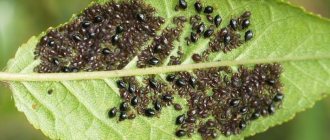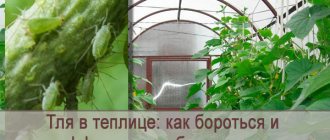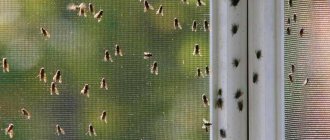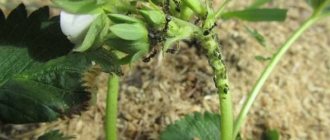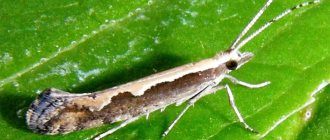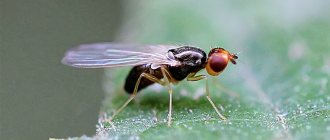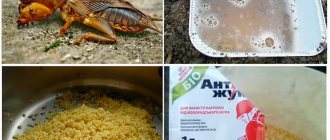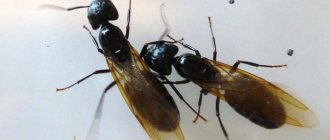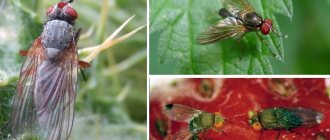Green, yellow, black or orange aphids love to settle on both garden and indoor plants. It does not spare anything; large fruit trees, bushes, vegetable and ornamental crops suffer from aphid colonies.
Aphids are carriers of some dangerous viruses. It also sucks cell sap from plants. At the same time, the pest releases poison, which causes the leaves to curl and young shoots to bend. The sweet secretions of aphids interfere with the normal functioning of the leaf. So the result of an unbridled feast of an aphid colony can be not only a loss of harvest, but also the death of the plant.
Perhaps only industrial pesticides can cope with an aphid invasion. But if you “catch” the bully right away, before it has time to reproduce, you can fight aphids using safer methods. There are many effective folk remedies against aphids. We'll talk about them today.
Glue traps and trapping belts for aphids
How to get rid of aphids this way?
Glue traps reduce the number of not only pests, but also ants, which spread insects. The hunting belt is a tape with glue that does not dry out when exposed to the sun. Traps can be purchased ready-made or made independently.
Traps are divided into two types:
- Sticky tape - intended for catching flies in a country house, but is also used for aphids. Hang traps on trees next to plants. Tape is a strip of paper onto which scented glue is applied. The composition does not dry, insects fly to the smell and stick. The product contains no toxins, only safe components - resin, rosin or rubber extract and various oils. Only the garden will look unaesthetic.
- Glue belt for wood - fixed on the trunk until the buds swell, so that pests do not penetrate the crown. Large catches are harvested daily. New glue is applied once a month. Buy a ready-made composition or make it yourself. Take ½ part of rosin extract, the same amount of petroleum jelly and 10 parts of pine resin. Mix the ingredients and cook for 5-10 minutes.
Life cycle of aphids
It is impossible to describe the life cycle of aphids in a nutshell, because... The development of insects depends on their type: non-migratory, migratory and incomplete.
Non-migratory aphids
Representatives : cereal aphid, cabbage aphid, green apple aphid.
Fruit crops become the primary host. Insects go through the following stages of development.
- Egg . In this phase, aphids overwinter on perennial (less often biennial) plants.
- Founder . Hatches from an egg in spring. It has no wings, so it lives on the same plant where it appeared, continuing to feed on its juices. It is a virgin female and, through same-sex reproduction, gives birth to about 50 rapidly developing larvae.
- The Wingless Virgin . This is what the foundress larvae are called. At this stage of development, aphids are faced with the task of reproducing a number of more generations of identical individuals. Moreover, among the summer generations, the first insects with wings appear - winged virgins, or dispersers.
- Winged settler . The main goal of the insect at this stage of development is to ensure the movement of the colony, i.e. capture of new territories (plants of the same species or related species). There they form and increase new colonies through viviparity.
- Oviparous female and normal male . The first full-fledged males and females emerge from the larvae of winged dispersers in early autumn. They mate and the female lays several eggs for the winter.
Migrating aphids
Representatives : bird cherry aphid, beet aphid, cherry aphid, etc.
Migrating aphids, unlike non-migratory aphids, have not one, but several types of food plants. And this leads to more complex development of insects. Winged dispersers, as a result of asexual reproduction, give birth to virgin migrants, who, in turn, give birth to midges. The moths return to the primary host, reproduce asexually, and give birth to normal females and males, who mate and lay eggs.
Incomplete-cyclic (analocyclic) aphids
Representatives : blood aphid, tobacco (peach) aphid.
The peculiarity of this group of migrating aphids is that they do not have the opportunity to fully develop on their primary host. Most often this happens due to the lack of plants in the region that can provide the necessary nutrition to the founders. Such aphids immediately end up on a secondary host, where they begin to reproduce asexually, giving birth to generations of virgins unable to lay eggs.
The life cycle of incompletely cycled aphids consists of the following stages: egg, foundress, winged virgin, wingless virgin. Formed colonies die with the arrival of autumn.
Soda ash for aphids
The method helps to quickly get rid of harmful insects.
The solution is made from the following components:
- 10 liters of clean liquid;
- 50-100 ml soap;
- 150 g soda.
The product, if it gets on the aphids, will cause it itching. After 2 days the insect will die. Spray with the solution in the early and late stages, when there are already fruits. Baking soda also helps in destroying fungal diseases. Treat once every 7 days.
Tips and recommendations from experienced summer residents.
Experienced gardeners advise remembering that if you destroy all the ants, the ecological balance will be disrupted. The ants will be replaced by more dangerous pests, the numbers of which were kept in check by the presence of the ants.
Therefore, gentle methods of control are recommended aimed at curbing the growth of the number of ants, and therefore aphids:
- plant plants that repel ants (cloves, tansy, valerian, marigold);
- the stems and leaves of these herbs are tied around the trunks of bushes and trees;
- use improvised means to repel insects (bone meal, soda, cinnamon);
- They use barrier methods (catching belts, adhesive tapes, hemp oil barriers) that do not allow ants to crawl through trees to reach aphids; without their protectors, small pests become prey for predators.
Mustard
Buy powder or make a solution.
The product is used in two ways:
- granules are scattered near anthills, where aphids also live;
- All shrubs and trees are treated with the solution.
Prepare a composition of 5 liters of liquid, 100 g of powder and a pinch of adhesive. All components are mixed and poured into a spray bottle.
Insect symbiosis
Symbiosis is a close, friendly relationship between living beings of different species, from which both species benefit.
During their life, aphids secrete a sweet liquid (honeydew), which the ants eat. This is the main source of carbohydrates for them, so ants provide aphids with protection, nutrition, and care, which boils down to the following points:
- The more honeydew the aphid sucks out of the plants, the more honeydew there is. Only young, tender leaves can provide an abundance of plant juice. The ants make sure that the aphids have constant food supply, transplanting insects onto young, not yet damaged shoots, thereby spreading the pests. If aphids reproduce too quickly and there are too many of them, the ants eat the aphids, keeping the numbers in check.
- Ants selflessly protect aphids from predatory insects and even birds.
- In the fall, ants carry aphids to the anthill for the winter, constantly caring not only for the adults, but also for the eggs. In the spring they replant aphids in the garden.
It is necessary to fight ants and aphids in the garden at the same time; they cannot exist without each other. Gortologists advise immediately starting the fight to get rid of both types of insects.
Laundry soap
When deciding how to get rid of aphids at home, prepare an effective solution. Take 10 liters of water and grate 100 g of soap. Mix everything well so that the components are combined with each other.
Plants are treated against aphids using two methods:
- Pour the composition into a spray bottle. All garden crops are irrigated. Repeat the procedure once a week. If it rains, the plants are treated when weather conditions improve. The method is suitable for berry bushes and crops in greenhouses.
- Using the resulting solution and a sponge, which you buy in a store, wash each leaf and twig from aphids. The method is suitable for currant and raspberry bushes and vegetable plantings. Repeat once every 14 days.
The product is used when they do not know how to treat trees against aphids.
Reviews from gardeners who destroyed aphids using folk remedies in their garden plots
Alena, 34 years old
I started growing vegetables myself when I had children. Naturally, I try without chemicals. It’s clear how to overcome beetles, slugs, and goose, we just collect them. But aphids. How did she get it? I used to buy chemicals at the store, but this year I decided to conduct an experiment first. I googled a bunch of recipes. I chose a few. I was able to wash it off with water, but the problem was that wherever the hose reached, I washed it off. And the garden is big. I tried a lot of things. In my opinion, soap solutions work well. I didn’t notice much difference in what to add. The main thing is soapy. Saved cucumbers with ashes. Good too.
Vladimir, 58 years old
We are adherents of healthy eating. What's the point of hunkering down in your city and treating it with chemicals if the same chemical stuff, but easier and cheaper, is available in the store. I already have my own methods for everything. I will share a recipe for aphids. Just dilute vinegar in water, about a tablespoon per liter. Spray or wash the leaves with this solution. Helps 100 points.
Maxim, 37 years old
My wife and I bought a dacha so that we could get away from the dust in the summer. They planted raspberries, currants, cherries, and apple trees. Its fresh. And then we arrive, and it’s all covered in insects. It turned out to be an aphid. We didn’t take anything with us; we were traveling for the weekend. And the next time, in a month, they could break out and devour everything. We started googling what available means would help. From what we had with us, we recommended cola and mustard. Well, we doused some with cola as best we could, and covered some with mustard powder. Before this, everything was washed with water. Not all the aphids were caught. But it has become much smaller.
Tar soap
Birch tar is a natural insecticide for pests. The remedy for aphids on plants is safe to use. Pure tar is difficult to find, but soap is sold.
If a natural component is found, then a solution is prepared from the following ingredients:
- 300 ml soap: laundry or cosmetic;
- 10 liters of tap water;
- 100 ml of tar concentrate.
All components are mixed. Leaves are treated with the composition against aphids. But tar soap is more common in stores. Prepare the solution in the same way as in the traditional method with laundry soap. The pungent aroma will remain on the plants for a long time and will repel pests. An excellent option for those who do not know how to kill aphids.
Experienced gardeners do not recommend spraying the solution during the flowering period. Bees, like aphids, will be frightened by the strong smell, and pollination will not occur. The method is suitable for processing in the early stages.
How to treat flowers against aphids? It is best to use tar soap, but follow the above recommendations.
Prevention measures
Preventive measures help to significantly reduce the risk of aphids appearing on apple trees. List of required actions:
- systematically control weeds, which are wintering sites for insects;
- plant fragrant herbs and plants for ladybugs, create wintering conditions for them;
- monitor the condition of tree bark and, if necessary, treat it in a timely manner;
- correctly dose tree feeding to maintain the balance of nutrients;
- use traditional methods for periodic watering and dusting of trees.
Ants love honeydew, so their appearance indicates an imminent or already occurring aphid invasion.
Tobacco infusion
The pest cannot tolerate the aroma of tobacco. Sprinkle the product around shrubs and garden crops. They also make a mixture. It is prepared from 10 liters of liquid and 3 tbsp. shag. Infuse the composition for 2-3 days. Before spraying, filter the plants. The prepared infusion is sprayed on the affected bushes and leaves of fruit trees.
How to prepare tobacco infusion:
- tobacco leaves or a glass of tobacco;
- 5 liters of liquid.
Infuse the product for 5 days, and then filter and process the crops. The method is suitable for combating aphids in the fall.
Method No. 1: Chemical methods
The use of factory chemicals in the form of an aerosol
One of the most effective ways to kill aphids is the chemical method. Currently, the chemical industry has developed several hundred special products that can quickly destroy insect colonies of any size. In addition, there are about a dozen lines of preventive medications that help prevent insects from appearing in the future.
Let's consider the use of these methods in more detail.
Classification of chemicals
Galls, a frequent companion of aphids
There are three main groups of chemicals used to control aphids. All of them are relatively mild insecticides with little harm to the environment. It is not recommended to use anything more serious (for example, acaricides and other remedies against thrips and ticks). These insects also die when relatively “weak” chemicals are used.
Depending on the type of insecticidal active substance, they are divided into:
- pyrethroids: Decis, Decis Profi, Ariivo, Iskra, Fury, Confidor and other intestinal pesticides, as well as substances of contact and enteric contact action;
- nicotine preparations: Vector, Ratibor, Bombardir, etc.;
- organic phosphorus insecticides: Aktellik, Aktara, Nurel, Fitoverm, Fufanon, Karbofos, etc.;
- biological products (containing bacteria that are pathogenic organisms for insects): Bitoxibacillin, Lepidocid, Bicol, Batsikol, Trichopol.
For direct control of insects, drugs from any of the listed groups are used. They are usually supplied in powder or ampoules. If the recommended doses are followed, the drugs kill insects within 2-4 hours.
For shrubs and small fruit trees, it is recommended to treat plants with systemic phosphorus preparations. It must be carried out before the buds open, that is, such treatment is preventive in nature.
Pyrethroid agents are used after flowering has ended. Nicotinoid preparations are used against aphids, which are located on plants affected by galls - such chemicals can successfully resist both aphids and the cause of the appearance of galls (various parasitic worms, other insects, etc.)
Frequency of chemical use
Insecticide “Aktellik”
If using insecticides it is not possible to completely rid the plants of aphids, they are re-treated. However, there are time restrictions on the use of drugs.
Nicotinoid agents are allowed for re-use no earlier than 21 days after their use. Pyrethroids and organophosphorus compounds - no earlier than after 14 days.
Restrictions on the use of chemistry
Biological products for plant protection
Despite the high efficiency of the chemical method of killing aphids, it has certain disadvantages.
Insecticides in any form are not harmless. In particular, they can cause the death of birds and especially their chicks, which their parents feed intensively in the summer. These products can also be dangerous for humans and care must be taken when working with them. Precautionary measures include protecting the skin, respiratory system and vision.
The main disadvantage of chemicals is limitations in processing during budding, flowering, ovary formation and harvesting.
But theoretically, aphids can appear on plants at any time, and you need to start fighting them as quickly as possible. If the use of insecticides is not possible, other methods of controlling aphids are used.
Wood ash
The powder is used as a natural fertilizer for fruit and horticultural crops. The product is recommended for beginners who do not know how to get rid of aphids on trees. The acidity of the soil decreases, so pests do not land on the leaves. The ash after burning wood is ground into powder.
Prepare a composition of 10 liters of boiling water, 2-3 kg of ash and 100 ml of garden special soap. The last component is replaced with a household liquid ingredient. The resulting composition is infused for 2 days. The prepared solution is used to treat all plants against insects in the garden.
Signs of a pest
You can detect the pest in the garden by carefully inspecting the trees, since its colonies are visible to the naked eye. Signs of aphids appearing on an apple tree:
- leaves rolled into a tube;
- crooked shoots;
- the formation of dark red spots and swellings on the leaves;
- deformation of tree tops;
- the plants look unhealthy, individual branches and young shoots wither.
When these symptoms appear, immediate treatment of the garden for pests is required.
Vinegar for aphids
The pungent aroma will repel the pest. In its pure form, vinegar is not used, as the leaves will get burned.
To treat plants against aphids, use:
- Apple vinegar;
- dining room;
- essence.
Mix a liter of water and a teaspoon of the main component in a deep bowl. If you use apple cider vinegar, use a double portion. An adhesive in the form of green soap is poured into the composition. Two or three sprays will help answer the question of how to remove aphids.
Causes of aphids
The parasite can get on home flowers in various ways:
- A winged female flew through an open window in the room.
- Delivered by a pet or a person on clothing. The larvae stick very well to people's clothing and animal fur.
- I was on a recently acquired plant, from which I quickly moved to others.
- Larvae were present in the mixture used for planting.
- They brought it along with flowers that stood outside, on the balcony or loggia in warm weather.
- They brought in ants that feed on the excess juice produced by this pest.
Iodine
Use with serum. Take a teaspoon of iodine and mix it with 10 liters of tap liquid. Add a liter of whey. All components are mixed well for 5-10 minutes, after which there will be something to spray against aphids.
The plants are sprayed with the prepared mixture. The treatment is repeated 3-4 times. Used both in early and late stages.
Hydrogen peroxide for aphids
The composition helps in the fight against pests and fungal microorganisms. 2 tbsp. spoons of hydrogen peroxide and vodka are dissolved in a bucket of water. Mix everything well and spray the crops. The mixture contains oxygen atoms which will improve the growth of garden plants. An excellent method for those who do not know how to get rid of aphids in the garden forever.
We fight pests. How to defeat aphids in your summer cottage
In order to get rid of aphids in a garden or vegetable garden, you need to know their development cycle and not miss the period that is most sensitive to pests. For example: it is useless to spray plants if eggs have already been laid on them. They are protected from the action of poison, they do not “eat” plants (they do not gnaw or suck out the juice from them), which means that poison is not scary to them. Processing of plants was carried out in vain. You need to wait until the larvae hatch, and then by spraying the pest is destroyed by 70 - 100%. It is the larvae, feeding day and night, that cause the greatest harm to plants.
Aphid development cycle
An adult female aphid lays overwintering eggs on branches and bark of trees and perennial shoots of shrubs. She places them near the kidneys. The eggs are oblong-oval, black, up to 0.5 mm long, visible to the naked eye. “Knowing” that it is warm under the snow, the female aphid lays eggs on root shoots and weeds. When wintering under the snow, almost all clutches survive. Aphids and housekeeping ants take care of the eggs. Until spring, they take the eggs into their underground homes, and in the spring, with the onset of warmth, they spread them.
Several generations of wingless females develop from overwintered eggs; reproduction takes place without males. In June-July, winged forms of disperser aphids appear. Aphids fly away at a distance of up to 25 km. In the fall, after mating, the female aphid lays fertilized overwintering eggs.
Thus, aphids have three most vulnerable periods: careful autumn preparation for wintering, the period of flight of female dispersers, the appearance of winged males and return to the host.
Measures to combat aphids
— Ash-soap solution. Pour 2 - 3 glasses of ash into 10 liters of warm water, leave for 2 - 3 days, strain, dissolve a piece of finely grated laundry soap in the solution and sprinkle during the budding period of fruit and berry crops.
— Garlic-dandelion infusion. Soak finely chopped dandelion plants (green mass and roots) and heads of garlic, 400 and 200 g, respectively, in 10 liters of warm water. Leave the mixture to infuse for 2 - 3 hours, strain and use for spraying during bud break and after flowering.
— Finely chop the onion peels together with the garlic (you can also use the heads), add warm water. Leave for 2 - 3 days. Strain, dilute the resulting solution 3 times and use it for spraying, and send the fermented mass to the compost pit.
Additional measures to combat aphids
Aphids are gentle pests and cannot tolerate strong, repulsive, spicy odors. Fennel, garlic, marigolds, and mint repel the pest, and petunia, mallow, begonia, and nasturtium attract it with their aroma. Plant the first ones in row-spacings along the edge of the beds, and the second ones further away. Your favorite scent will attract aphids. But in the fall, the above-ground mass of these flowering plants must be destroyed, since aphids place their overwintering oviposition on them. Viburnum, bird cherry, and linden also attract aphids. Use them in distant landscape plantings.
People say: without a nightingale, spring is poor, and a garden without a bird is orphan. Decorate your garden with birdhouses, and propagate calendula for ladybugs (the worst enemies of aphids). For lacewings, hoverflies, wasps, ground beetles and other insects, caraway seeds, parsley, marigolds, navel, dill, and coriander are suitable. The less chemicals are used in the garden, the more nests of kinglets, warblers, tits, and wagtails will appear, which will be happy to help you clean the garden of pests. The choice is yours - to be on friendly terms with nature and not poison it with pesticides, or to be alone in a clean but “dead” garden.
Chemicals to control aphids
The most well-known insecticides with a quick killing effect are actofite, karbofos, intavir, actara, spark, tanrek, commander and a number of others. The list of insecticides approved for use is supplemented and changed annually.
When working with chemical insecticides, it is necessary to wear protective clothing, gloves, goggles and a respirator. They should be used only as recommended. Increasing the dose and shortening the waiting period until the next treatment will not provide the expected positive effect. Knowing their negative impact on health, in small gardens and berry fields it is better to use biological preparations.
Biological preparations to combat aphids
For biological products, the period of influence on the pest’s body is 10 - 15 days. They are absolutely harmless to people, birds and animals. You can spray the plants with them until harvesting. After treating the plants with some biological preparations, the fruits can be used for food already on the second or third day.
The most familiar bioinsecticides include bitoxybacillin, acarin, spark-BIO and others. They are based on living beneficial microorganisms (various groups of fungi and bacteria). Bioinsecticides are effective in protecting plants not only from aphids, but also from other pests.
Bioinsecticides that can be used even during plant flowering include the bioinsecticide trichopolum (a drug used in official pharmacology as a treatment for bacterial infections). For spraying, dissolve 20 tablets in 10 liters of water. Compatible with many other biological products, but still requires compatibility testing. Trichopolum can be sprayed not only on trees and shrubs, but also on vegetable crops (tomatoes, cucumbers, dill, etc.). The duration of action is limited by precipitation, but immediately after the rain stops, spraying the plants can be repeated. You can work with the solution without special clothing. The drug is remarkable in that it simultaneously destroys fungal diseases of crops along with pests.
Each female lays up to 100 eggs for the winter. Of these, 100 females develop, which mature in 1.5 - 2 weeks and themselves lay an average of 100 eggs. During the growing season, one female is capable of increasing the offspring of up to 15 - 20 thousand pests per season.
At home, you cannot prepare decoctions and infusions from poisonous herbs (hemlock) and spray crops with them: someone in the family may eat a fruit or vegetable and get poisoned.
Author: Larisa Sitnik
Ammonia
Another folk mixture is prepared from the solution to combat insects in the garden. Mix 50 ml of alcohol, 10 liters of liquid and 2 tablespoons of adhesive. Green or laundry soap is used as the last ingredient. With this product you will have something to kill aphids.
The prepared composition is sprayed on all garden crops. Repeat the procedure after rain, as aphids appear on the plants again. The composition is also suitable for feeding.
What are aphids and how to recognize them
The body shape of an adult aphid can be teardrop-shaped, oblong, ovoid or hemispherical. The length varies from 0.3 to 0.8 mm. The integument is soft and, as a rule, transparent. The color most often matches the color of the food substrate and can be green, gray, brown, beige, red, black, etc. Often there are outgrowths, tubercles, fluff and hairs on the body. Let's take a closer look at some common aphid species.
Leaf gall aphid
Favorite food: leaves of white, red and black currants. The easiest way to detect the pest is by the galls that appear on the plant - yellow or burgundy swellings.
Beet, or bean, aphid
It affects poppy, jasmine, viburnum, sunflower, legumes, beets and potatoes. The vital activity of aphids leads to curling and wrinkling of the leaves of the plant, as well as to a significant slowdown in its growth and even death.
Melon or cucumber aphid
This type of aphid can be found on melon crops - watermelons, pumpkins, melons, cucumbers; it also affects sesame, peanuts, and beets.
Cabbage aphid
Favorite habitat is radish, cabbage and radish crops.
carrot aphid
Causes serious damage to carrot crops, as well as other plants of the Apiaceae family. The pest sticks to the leaves and stems, which impairs the nutrition of the root crop and reduces the crop yield.
rose aphid
Settles on roses, rose hips, as well as strawberries, apple trees and pears. Plant leaves curl, and the crop itself weakens and loses its ability to resist viral diseases.
Potato aphid
Harmful to cabbage, potatoes, beets, tomatoes, as well as greenhouse and indoor plants.
Greenhouse peach aphid
Lives on peaches, cherry plum, tobacco, cabbage, potatoes, radishes, dill, cucumbers, parsley, lettuce, and greenhouse crops.
Mealy, or hairy, aphid (mealybug)
Settles on greenhouse and indoor plants, as well as on citrus fruits and grapes. As a result of a pest attack, the leaves become covered with a powdery coating, the stems become deformed, and the buds dry out and fall off.
Infusions from plants to combat aphids
To create mixtures at home, different herbal extracts are used:
- pour boiling water over pine needles and leave for 8-10 hours;
- crush the sorrel roots and pour in cold liquid, leave the mixture for 2 days;
- take potato or tomato tops, mix with 10 liters of liquid and 4 kg of finely chopped leaves, leave overnight, boil, cool;
- infusion of celandine: add 1 kg of finely chopped leaves to 10 liters of water, boil and cool, filter and add liquid soap before use.
Folk remedies for aphids are effective and safe. Gardeners use them not only to protect garden crops, but also to fertilize them with nutrients.
What are aphids?
The appearance of aphids always occurs in large colonies. First of all, the pest appears on the tops of trees, gradually descending to other parts of them. As the family grows, females with wings are born in it. Flying around the garden, they have the opportunity to choose more suitable places to live, thereby infecting other plants.
The peculiarity of the aphid lies in its oral gnawing apparatus, with the help of which it obtains nutrients from the leaves of trees and other green crops. The insect's favorite treat is juicy young shoots and flowers. There is a type of aphid that feeds on the bark and roots of trees. By sucking nutritional products from the plant, the pest weakens it, as a result of which it develops and grows incompletely.
